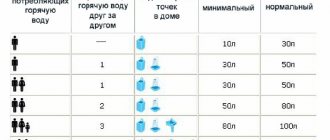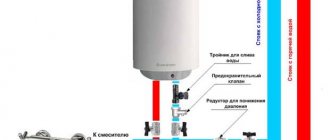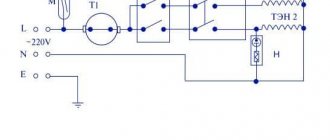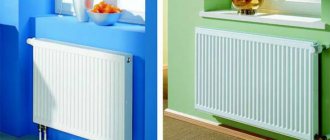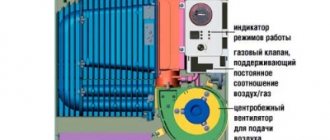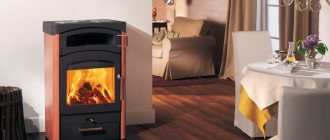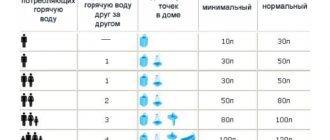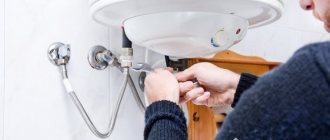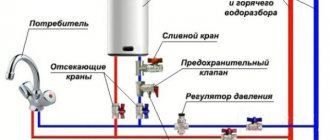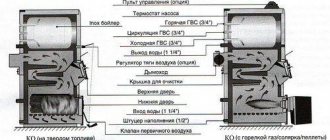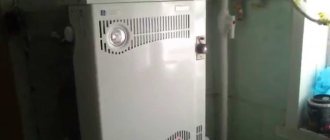The lack of centralized hot water supply today is a problem not only in small settlements, but also in large cities. Sometimes the water can be turned off, or it has different temperatures at different times of the day, or it is too rusty. Naturally, not everyone is ready to pay for hot water, which is often turned off or supplied in poor quality. That is why installing a boiler is the best solution to provide yourself and your family with hot water supply when needed.
Today’s material will be devoted to how to install a water heater in an apartment or country house. The material also contains a training video regarding the features of installing boilers with your own hands.
Boiler installation: video
Manufacturers of water heaters offer customers of their products various modifications of their products, which are designed for installation both in a house and in an apartment, both in the bathroom and in other rooms. Depending on the needs, boilers have different tank volumes.
The most common types of electric water heaters in everyday life are:
- accumulative;
- flow-through.
Both types of boilers have their own operating characteristics, but each of them, if connected correctly, will provide hot water to both the tap and the shower at the same time. Thus, if you install the water heater in the right way, you can get hot water both in the bathroom and in the kitchen from one device.
Regardless of the type of design, an electric water heater operates on the principle of converting current energy into thermal energy. Therefore, both types of boilers are equipped with a heating element. If you have a connection diagram, tools and consumables, you can easily install a boiler in your apartment or country house with your own hands.
Below we attach a training video on how to install a water heater with your own hands, and what you will need for this.
Gas heater installation
Installing a horizontal gas water heater is more difficult than an electric one. In this matter, it is better to turn to professionals. But in case of self-installation, you must strictly follow the instructions, symbols and rules. The ceiling height must be at least two meters, and the room area must be more than 7.5 square meters. meters. In addition, the room must have a window; in addition, the room must have a door. Most often, such devices are installed in the kitchen, next to the gas pipe.
A very good way to detect gas leaks is to install a gas analyzer. Such a device detects a propane leak and gives a warning signal. But ventilation is also required. For proper operation of a gas water heater, a chimney must be connected to it. It can be included in the overall system or taken separately directly to the street. It should not have more than two right angle bends, and its total length should not exceed three meters. When installing equipment on a wooden wall, the chimney should not come into contact with it. Be sure to lay thermal insulation, for example, from mineral wool.
You need to know that a gas water heater should not be placed on a load-bearing wall. The distance to the opposite wall must be at least one meter. Gas pipes must not be installed in walls. But you also need to take into account that gas equipment cannot be placed above the stove. It is not advisable for the water heater to be constantly exposed to sunlight and overheat. In order to check the tightness of gas pipes, you can use ordinary soap. It needs to be dissolved in a container of water, and then applied to the pipe joints with a brush. If bubbles appear, there is a leak. And it must be urgently eliminated. It is prohibited to check pipes for leaks using fire. This can lead to irreparable consequences.
DIY installation features
Naturally, in order to install any type of water heater in a house or apartment with your own hands, you need to at least at a minimum level understand the features of working with plumbing and understand on what principle the boiler works.
When installing a water heater, you should not overlook even the smallest details of the work, otherwise you can disrupt the entire connection diagram with your wrong actions and the device will not work correctly.
Of course, installing a water heater with your own hands will save money on the work of a craftsman, but you will still have to buy accessories for installing the structure. Also remember that depending on the type of boiler, it should be installed in accordance with safety regulations.
So, before installation you should do the following :
- clearly think about where the structure will be placed;
- there should be free access to the boiler not only during its installation, but also during subsequent use;
- the wall where the water heater will be installed must be level and support the weight of the structure;
- Pay attention to the condition of the electrical wiring in your home. When installing water heaters, the quality of the wires and their condition are an important condition for safety during their use;
- check the condition of all pipes and risers. Replace them if necessary;
- Keep with you a connection diagram indicating the piping for the faucet and shower.
As a rule, the boiler design includes the following elements:
- frame;
- power cord;
- water outlet pipe;
- pressure valve.
Necessary tools for installing storage heater
Any installation begins with the preparation of tools. If it is fully equipped, then the work will be done quickly and efficiently.
To install the boiler you will need:
- a drill with an impact mechanism or a hammer drill plus a set of drills for concrete;
- screwdriver;
- a grinder if the water supply is made of metal pipes, or a pipe cutter if it is made of plastic;
- a pair of gas wrenches or adjustable wrenches;
- building level;
- pliers.
Additionally, you may need a tool for installing pipe connections:
- for steel water supply: welding machine and set of dies for threading;
- for polypropylene: a heater for welding pipeline parts (it is called a soldering iron or iron);
- for metal-plastic: press pliers, if you plan to use press fittings, as well as calibration to align the end of the pipe before installing the fitting.
In addition to tools, you will need sealing material to seal the threaded connections between the pipeline elements. For this, experienced craftsmen use tow or plumbing flax in combination with Unipak paste, but a beginner will find it easier to work with FUM tape or a special flax thread such as “Tanget Unilock”.
7b2feb9ad864df6ea91eb5883aa37213.jpe
Features of choosing a water heater
The choice of water heaters in specialized stores, markets and on the Internet is now huge; they differ from each other in volume, power, type of installation, price and other parameters.
It is quite natural that anyone wants to purchase a model that would combine a reasonable price and decent quality, and at the same time have a number of useful functions.
So, what should you consider when buying a boiler , regardless of its type, manufacturer and cost:
- the design must be reliable;
- It is desirable that the water heater be universal in terms of installation, especially if you are planning to move from your apartment to your country house for the summer;
- both storage and instantaneous water heaters must simultaneously supply water to the shower and tap;
- it is desirable that the design includes a safety valve as a protective measure against malfunctions;
- the boiler must be made only from high-quality materials;
- the design must be such that the device can be installed at home with your own hands and online;
- the product must be attractive in appearance and be of high quality;
- When purchasing a water heater, be sure to ask what conditions exist for its correct operation, so that in the future it does not become unusable ahead of time.
Preparatory work
Connecting a boiler to a water supply with your own hands is not a very difficult task, which any self-respecting owner can cope with.
Preparatory work for connecting the boiler includes:
- Detailed study of the instructions supplied with the boiler.
- Installing a boiler on the wall.
- Supply of water pipes to the boiler. If the boiler is located near a water supply, and an open one at that, the task is simplified and this point can be omitted. Otherwise, the water supply must be connected to the boiler using metal-plastic or polypropylene pipes.
- Preparing the necessary tools: tape measure, pipe cutter, soldering iron for plastic pipes or welding, adjustable wrench.
- Purchase of related materials: shut-off valves, fittings, tees, pipes or flexible connecting hoses, American women, flax tow and fum tape.
Advice. When choosing related fittings, keep in mind that cheap, low-quality materials will not last long.
4087a390c8dac9de4593521a32e70313.jpe
Do-it-yourself boiler installation
You need to install a water heater yourself in accordance with existing rules and requirements, depending on its type. Thus, the features of installing a flow device will be somewhat different from installing a storage device. Let's look at both cases one and two.
How to install a instantaneous water heater
One of the key features of instantaneous water heaters is their compactness, which allows you to place them in the kitchen or bathroom right under the sink. The liquid in such devices is heated in a special metal pipe that contains powerful heating elements.
Such design features of the device require that the electrical wiring in the house or apartment works properly and is able to withstand heavy loads. It is advisable to install a separate machine for a flow-type heater, and connect a wire with a large cross-section .
After you finish working with the electricity supply, you can install the boiler itself. It is installed either temporarily or permanently.
The temporary scheme provides for an additional tee to be cut into the cold water pipe, which will be connected to the water heater through a special valve. To do this, you need to apply voltage to the water heater and open the tap that supplies hot water.
But the stationary scheme assumes that the supply and intake of water in the pipes will be carried out in parallel with the general water supply system. To install the structure according to a stationary scheme, tees for hot and cold water are cut into the pipes. Then you need to install shut-off valves and seal them with simple tow or fum tape.
Next steps are:
- connect the boiler inlet pipe to the pipe that supplies cold water;
- connect the outlet pipe to the hot water supply tap;
- supply water to the pipes and make sure that all connections are tight when turning on the water in the tap and shower;
- during normal operation of the system, you can supply electricity to the water heater, then hot water should flow from the desired tap;
- To increase the safety level of the entire plumbing system and water heater, immediately install a safety valve along with it.
You can clearly see the installation process of the flow apparatus in the video.
Rules for installing a storage boiler
If you plan to install a storage type device , then the requirements for the condition of the wiring will not be as strict as in the previous case. Storage heaters are also somewhat cheaper than flow heaters. In addition, their popularity can be explained by the fact that very often they are covered by a scheme in which water can be supplied to the tap and shower at the same time.
If you have the tools and materials, you can install such a unit quickly; the work itself will not seem too complicated; it consists of the following actions:
- eliminate faults in the electrical wiring or plumbing system, if any, check their condition;
- make markings on the wall for the structure and install the necessary fasteners for its installation;
- fix the water heater on the wall and attach the safety valve;
- after installing the boiler on the wall, connect it to the water supply;
- route the pipes through the valve to the corresponding inlets and outlets on the body;
- first install and connect cold water, and the safety valve must be closed at this time;
- Also, with the valve closed, install pipes for hot water;
- connect the structure to the electrical network and check how it works.
If all steps have been performed correctly, hot water should flow from the appropriate tap. At this time, all pipes and connections of the boiler should be well sealed , and the wires should not overheat.
Of course, if you are not confident in your abilities and even visual training material in video format cannot help you learn the features of step-by-step installation of a boiler with your own hands, then do not take risks, but invite a specialist. Incorrect installation of the heater can cause it to fail prematurely and cause leaks and other problems. Therefore, undertake self-installation only when you are confident in your abilities and know that everything will be done efficiently and correctly.
Features of mounting a boiler on a thin wall
Ideally, the water heater should be mounted on strong brick, concrete or block walls, since the device, together with water, has quite a lot of weight. But sometimes the device needs to be hung on a thin plasterboard, frame, wood, aerated concrete or foam block base. In this case, you will need to strengthen the wall and use special fasteners.
The water heater cannot be mounted directly on a wooden wall for fire safety reasons. First, it needs to be well insulated from heat, for example, with profile iron, which is used for roofing.
In other cases, special fastenings are used:
- spiral nylon dowels;
- metal fasteners for mounting boilers with a capacity of 100 liters or more.
If you plan to hang the water heater on a wall made of foam concrete blocks, you will need metal dowels or special chemical (adhesive) anchors for foam concrete. Chemical anchor is a universal fastener that can withstand high loads. It is environmentally safe and resistant to low temperatures.
The expansion dowel is held in the wall due to frictional forces in the expansion joint, and the chemical anchor is held due to the adhesion of a special adhesive composition
Attachment to an adhesive anchor is carried out in the following way:
- A hole is drilled to expand the channel by rotating the drill at an angle in different directions.
- Concrete dust is removed from the hole.
- The hole is filled with a quick-hardening mixture, into which a fastening sleeve or threaded pin is inserted.
The resulting cone-shaped plug provides fairly high fastening strength.
For installation in hollow structures, an anchor sleeve is inserted into the hole, and a pin is screwed into it
Video: how to hang a water heater on an aerated concrete wall
Connecting a storage boiler
To supply and drain liquid, fittings are installed at the bottom of the water heater (storage). The connection for hot water is marked red, and the connection for cold water is blue. It is recommended to use polypropylene pipes, which provide a reliable connection.
The figure below shows the simplest and most reliable diagram for connecting a water heater to a water supply.
The following rules must be observed:
- it should be possible to shut off the water supply to the home using valves;
- branches leading to the unit must have shut-off valves;
- if low-quality water is supplied to the mains, it is necessary to install a water filter after the shut-off valve;
- It is necessary to install a drain valve between the entrance to the tank and the safety valve, which allows you to quickly drain water from the tank if repair or maintenance of the device is required;
- Before connecting the storage water heater to the water supply, you must first acquire various types of fittings, T-branches (tees) and flexible and rigid connecting pipes.
In addition, connecting a storage water heater requires the mandatory installation of a safety group of two valves. A safety valve is installed to protect the tank from excess pressure. If it rises to a critical level, the valve opens and the liquid is discharged through the drain hose into the sewer or a special container. The check valve prevents water from flowing out of the tank when the pressure in the line decreases or is absent. Thus, it prevents heating elements from drying out, overheating and burning out.
The connection diagram of the water heater (boiler) to the water supply system is shown in the figure:
For iron or steel pipes
How to properly connect a boiler to the water supply if the apartment (house) has a mains pipe using standard iron pipes? You can use a modern connection method, without the use of welding (welding an adapter with a thread). In this case, a “vampire” adapter is used, which is a clamp supplemented with a hole and thread.
Adapter "vampire"
Installation of the clamp is very simple, and is carried out as follows:
- the place on the riser must first be cleaned of paint and rust;
- The clamp must be placed on the riser using rubber gaskets, and the bolts must be tightened to secure it;
- turn off the water supply and drain the remaining water by opening any mixer tap;
- drill a pipe through the hole in the clamp using an electric drill;
- then, having screwed on the tap, you can begin connecting the required elements.
For metal-plastic pipes
Connecting a water heater to such a water pipeline is the simplest. Metal-plastic bends easily, and various types of crimp fittings are used to connect the elements.
Connection steps:
- cut the pipe to the required size;
- Next, you will need to carefully select the place for the insertion, while you need to take into account the size of the tee minus the part of the pipe that will go into the connection;
- you can use special scissors to cut out a small area;
- it is necessary to remove the nuts from the tee and place them together with the fixation rings on the 2 ends of the pipe;
- flare the ends of the metal-plastic using a special calibrator or screwdriver;
- Insert the tee all the way, after which you need to move the rings and tighten the nuts with a wrench.
For polypropylene pipes
Before connecting the boiler to the water supply using polypropylene pipes, you need to prepare: a soldering iron for soldering plastic water pipes, scissors for cutting it, a pair of tees and adapters for the threads that are located on the valves and emergency valve, as well as the quantity required for the design corners. Further:
- the connection location is selected;
- a section is cut out in the pipe equal to the width of the tee, minus 2 centimeters (1 cm will go into the tee on each side);
- using a soldering iron, it is necessary to heat the pipe and fitting to the desired state and connect them (they cannot be turned during connection, as this may break the seal);
- using sections of water conduit of different lengths and angles, connections are made to the nozzles of the unit;
- A threaded coupling is soldered onto the end of the water conduit, after which the entire structure is securely connected.
Choosing a location for installing the device
Storage water heater is installed both in apartments and in private houses
It is important to choose a place for installation so that the device functions without failure and does not cause inconvenience, given its small size
There are recommendations for this:
The drive is placed in the bathroom or toilet. It is necessary to choose a place so that there is easy access to the device for its maintenance, even if it is placed in a niche. Storage in the kitchen will take up a lot of space
It is better to install a compact instantaneous water heater there. Particular attention is paid to the strength of the walls. Steel anchors are used as fastening elements. Connecting the water heater to the water supply in close proximity will ensure minimal loss of liquid temperature
Water loses less heat over a short path: shorter pipes mean fewer losses. It is recommended to connect the storage device directly to the panel using a cable with copper wire. Therefore, the minimum path must be chosen. The choice of location will be affected by the manufacturer's recommended position of the tank. It can be mounted horizontally or vertically. There are boiler models for which both options are possible.
A coarse water filter installed during installation of the water heater will help extend the service life of the device. It is not included with the water heater. Sold separately.
If there is no waterproofing of the floor in the room where the boiler will be installed, a special tray is made directly under the device to drain into the sewer through a drainage pipe. Such a tube also does not come included. You can purchase it yourself.
Main types of water heaters
Devices for heating water to the temperature desired by the user can have different designs and configurations.
The range of water heaters is very extensive
According to a separate classification basis, all boilers can be divided into types:
- according to the method of water treatment - storage and flow;
- by power source – electric and gas;
- by form factor - cylindrical, flattened, rectangular;
- by connection location - vertical and horizontal;
- according to the degree of activity - indirect and active;
- by installation method - wall and floor;
- by type of control - mechanical and electronic.
The variety of equipment presented serves to most fully and adequately satisfy diverse user needs. For example, for a private house with an autonomous gas or solid fuel boiler, an indirect heating boiler is perfect. It does not contain a built-in thermoelement, and the water in it is heated from a heating boiler. By the way, such units are usually floor-standing, making it more convenient to connect them to a similarly located boiler. In an apartment building, this option is unacceptable.
Storage electric boilers
It is this type of water heating technology that has given the word “boiler” a place in the mass consciousness.
Typical representative of the budget segment
The source of energy for heating is the household electrical network. Structurally, the boiler is a container filled with water from the water supply. A built-in thermal electric heater (or simply a heating element) increases the water temperature to a set value. A thermostat helps him in this - a device that records the water temperature and turns off the heating when the required values are reached. Usually it is combined with a scale and a switch, on which the user can set the parameter he needs. For the most part, electric boilers are wall-mounted units. This is driven by the desire to save space in small spaces in bathrooms and kitchens.
The filling can be either electronic or mechanical. The advantage of such devices is their versatility . It is rare that a home is not connected to electrical networks. Sometimes this is the only type of energy source in the area where the house is located. For apartment buildings, installing a boiler where there is neither centrally supplied hot water nor gas, this becomes the only solution to create minimal comfort. The boiler also becomes an indispensable assistant in those apartments where there are frequent interruptions in the supply of hot water, or it is supplied on an hourly basis. Apart from high energy consumption, such a product has almost no disadvantages . The device is completely safe if the installation rules are followed.
For more detailed information, see the article on how to choose an electric storage water heater for an apartment and connect it. Information about the main advantages of storage tanks, as well as nuances that should be taken into account when hanging a boiler.
Flow-through electrical devices
Structurally very simple, and even much more compact than other models.
Takes up almost no space
They are in demand when installed in places where there is physically no room to place a large boiler . Such a boiler consists of a curved channel along which a heating spiral is laid using the entwining method (external placement of the spiral) or the coaxial cable method - the spiral in a waterproof tube is located inside the channel through which water moves, repeating all its bends. To heat water to the required values under high pressure, it is necessary that the thermoelement heats up very quickly and to high values. Therefore, the power of flow devices is always higher than that of storage devices - about two to three kilowatts. But the heater works only at the moment when the water is turned on - the rest of the time it is inactive, blocked by special fuses from accidental operation. Possible areas of application are points with occasional and short-term water withdrawal, for example, washstands or shower heads. Drawing a bath of hot water this way will be expensive.
Gas storage devices
This type is rare, although in terms of water heating costs it is one of the most economical. The reason is that where it is possible to use gas to produce hot water, instantaneous water heaters are installed much more often. The temperature generated by the gas burner is more than enough to heat the flowing water. Instantaneous water heaters are more compact than storage water heaters, so most users see no point in installing a larger household appliance. To install it, a full-fledged smoke exhaust duct with working ventilation is required. An open type burner consumes air directly from the room. Given the small volume of bathrooms, a constant supply of oxygen is needed for combustion so that the air does not become stale. The significant advantages of this type of boiler are high heating speed and efficiency indicators .
A rare guest in Russian apartments
Gas water heaters
Such units are almost never called boilers, because they have a special name - columns. Entire houses and neighborhoods that do not have a central hot water supply, but have a connection to the gas main, are equipped with instantaneous gas water heaters. They have been known since Soviet times, but since then they have become much more compact, more accurate, safer and “smarter” thanks to the electronic control board. The heat exchanger through which water runs during the heating process is always smaller than the storage tank with burner, especially when it comes to volumes of more than 50 liters. Gas consumption is slightly higher than in gas storage appliances, but it is still cheaper than heating water with electricity.
Compact and economical
Prices for popular models of gas instantaneous water heaters
Gas instantaneous water heater
Video - All about water heaters. Selecting a water heater, operating principle, installation, startup
How to choose the right boiler
When choosing, you need to take into account the various parameters of boilers, and focus on the most suitable one.
Shape and size
At first glance, the shape of the boiler creates only an aesthetic effect and does not affect the design in any way. However, when combined with volume, and therefore the size of the device, the shape can make use more comfortable.
Buyers of an electric or gas water heater are faced with the question of the volume of water that will constantly be spent on household needs and must be accumulated in the tank in a heated form. At the same time, it is impossible to make a calculation by simply adding up the approximate norm of 30 - 50 liters per person - then the figure will turn out to be too impressive. This is not necessary, since all family members never use hot water at the same time and do not drain their entire supply at one time. But much depends on the nature of the water collection points.
Volume matters a lot
For example, if the apartment has a shower, then the consumption will be the same, but if there is a spacious bathtub that is filled several times a day, it will be much more. Approximate recommendations for choosing the volume of the storage tank are given in the table:
Table 1. Approximate boiler volume per family.
| Number of people | Minimum volume, l | Optimal volume, l |
| 1 | 30 | 50 |
| 2 | 50 | 80 |
| 3 | 80 | 100 |
| 4 | 100 | 120 |
| 5 | 120 | 150 |
As can be seen from the table, the optimal volume for a certain number of people in a family is also the minimum capacity of the device for a family with more than one person. This means that the boiler can be used, and in most cases its volume will be sufficient, but the risk increases that with intensive use, one of the family members may end up with cold water.
Small boilers of 30 or even 20 liters will be convenient not as the main one, but as a point source of hot water, for example, for a kitchen sink or washbasin. Among the most typical form factors in which water heaters are manufactured, two options predominate:
- cylindrical;
- flattened.
In this case, the ratio of the metric characteristics of a cylindrical boiler varies. Many 50-liter options are equipped with tanks that are large in diameter but small in height. It is optimal to place them at a certain height, under the ceiling of the bathroom - then they do not “eat up” the usable area, and you will not hurt your head on them. Larger capacity boilers are made vertically elongated. While maintaining the volume, this allows you to reduce the thickness. Any cylindrical boiler is convenient for installation in a corner .
Typical corner location
Flattened boilers appeared on the market later than cylindrical ones as an attempt at a more ergonomic solution. They have rounded edges and corners, so they do not look bulky or heavy. But their advantage is not only in appearance. Thanks to its flat design, a 100-120 liter has a thickness that is two or more times smaller than its cylindrical counterpart. Such units can be placed not only in corners, but also on an open wall.
Modern boilers can have not only a bottom communication connection, but also a side and even top connection. The layout of the input and output fittings does not affect the operation of the device; it is intended for ease of connection. When choosing a boiler, immediately figure out where you are going to place it and what the shape of the connecting pipes or flexible hoses will be. Thus, for a lower location under the sink, an upper arrangement of mounting pipes is provided. A common side connection diagram is for horizontal flat boilers.
Prices for popular models of indirect heating heaters
Indirect Heaters
Tank material and thermal insulation layer
Since manufacturers have been producing different types of boilers, there has been ongoing debate among users about which tank is better in terms of performance characteristics. Most tanks are made with enamel coating and stainless steel.
The enamel is applied to the inner surface of the tank, which consists of ordinary iron. The stainless steel tank is homogeneous, but has a welded seam. The warranty for devices equipped with different types of tanks can range from 1 year for enameled and glass-ceramic tanks to 5 years for stainless steel ones. This indicates a longer service life of stainless steel as a material in contact with water.
Interior view of a stainless steel tank
But enameled boilers have one indisputable advantage - an affordable price. This trump card for many buyers trumps other considerations. In addition, with proper operation and the presence of a magnesium anode, which reduces the deposition of solid sediments on the walls and heating element of the water heater, the latter successfully serves its owners for many years.
Other characteristics
Each boiler has a certain group of features that do not directly affect its operation, but can optimize operation and make it more convenient:
- Control type. The mechanical system contains a physical type sensor, which, when a certain water temperature is reached, expands and opens the electrical circuit that supplies current to the heating element. The sensor is connected to a handle and a graduated scale. All boilers, regardless of the type of control, are equipped with an LED indicator , which signals the readiness of water in the device. Electronic control is a push-button or touch panel, to which in boilers priced above average is also attached a display, which displays all information about the state of the unit. Electronic control is more accurate and reliable, but it has a higher risk of breakdown, and its repair will cost a considerable amount.
- Degree of protection. Users rarely pay attention to this parameter, but in vain, because the safety of use depends on it. Since contact of water with conductive materials is theoretically possible in a boiler, it must necessarily provide protection in case of breakdown of the heating element . A ground loop is also required.
- Case thickness. The thicker the walls of the boiler, the better , because a layer of heat insulation is laid between the outer shell and the inner tank. The better quality it is, the less the water in the device will cool during the day, if you don’t even open the tap.
Sometimes a remote control is also included
Advantages and disadvantages of instantaneous water heater
Water heater installation
Advantages
- Compact sizes. The flow heater does not take up much space. At the same time, heater models are available for sale, equipped with a mixer and shower head, which allows for additional savings.
- Fast heating. Unlike storage-type models, flow-through heaters begin to produce warm water 30-60 seconds after startup.
- No restrictions on the volume of heated water. The user can get exactly the amount of hot water he needs, unlike storage tanks, which have a limited volume.
- Relatively low price.
Flaws
- Relatively high energy consumption.
- Requirements for wiring, machine and meter.
- Limited performance. This drawback is relevant only for low-power and compact budget models capable of preparing hot water exclusively for the bathroom. If you need to arrange the wiring and the kitchen, you will have to spend more money on purchasing a more energy-intensive and larger model.
- Relatively expensive to operate due to significant energy consumption.
Instantaneous water heaters are best suited for houses and apartments equipped with electric stoves. In this case, the meter and electrical wiring will already comply with regulatory requirements.
Connection to a water pipe
To connect the water heater to cold water and hot water supply you will need:
- wrenches (it’s better to take a couple of adjustable ones);
- FUM tape;
- tees for inserting into existing pipelines;
- two shut-off valves;
- safety and check valves;
- plastic pipes or metal braided hoses;
- pipe cutter and soldering iron for plastic or corresponding fittings;
The process of connecting a boiler to water supply systems comes down to connecting two pipes (cold water inlet and hot water outlet) to the threaded pipes on the heater body. And the main point here is the correct insertion of tees for these branches into the existing water supply pipeline.
The procedure for connecting the boiler to hot water consumers
Insertion into a metal-plastic pipe
If the water supply is made of metal-plastic pipes, then compression or press fittings will be required. When connecting a water heater, the first ones are easier to work with; you need to tighten the nuts with wrenches. And the latter are more reliable, but form a permanent connection.
To install the tee, you will need to cut out a section of the appropriate size on the pipeline. To do this, it is better to use a pipe cutter, but you can also use a hacksaw with fine teeth. You just need to make sure that the aluminum layer of metal-plastic does not protrude later on the cut edge. The foil can be pulled inside the pipe, causing the latter to become narrower.
Boiler connection diagram and consumables
Polypropylene
If you need to connect the boiler to a water supply system made of polypropylene pipes, you will need a soldering iron. The incision is made in the same way as in the case of metal-plastic. Then the tee is heated on one side and soldered to the pipe, and then its second end is soldered. On the side there is a free end with a thread for connecting the outlet from the water heater.
Options for water supply schemes through the boiler
Steel pipes
You will have to tinker with steel pipes. Here you need to either take a grinder and then cut a thread to connect the tee with a die or clamp, or install an overhead clamp (“vampire”, tee-clip) and drill the pipeline.
The first option for connecting a water heater to a water supply is more difficult to install and more reliable in operation, while the second is faster and simpler, but not as durable. But here’s how to connect the washing machine drain to the sewer system - you can simply hang the drainage hose on the bathtub, or you can install a tee with a side outlet. In the second case, the reliability will be an order of magnitude higher.
With steel water pipes, everything is in many ways similar. However, both the inserted tee and the overhead clamp give approximately the same result. Moreover, if you have no experience working with an angle grinder, then it is better to use the second option.
Steel pipes are not easy to connect, so most often this option is for connecting to a boiler for industrial needs or intensive use
Cold water connection and hot water outlet
Ithaca, the boiler has been selected, consumables have been purchased, and the tools have been prepared. Self-installation of a boiler does not require permission from utility services, drawing up projects or other documentary evidence. In practice, the scheme for connecting a boiler to a water supply is simple. The water heater must be connected to the water supply after the water meter, for example, at the location where the valve is installed on the toilet cistern. Typically, when laying pipes around an apartment, a diameter of ½ inch is used. Inserting a tee to connect the boiler should only begin after shutting off the cold water to the entire apartment.
Diagram of connecting the boiler to the water supply.
To create a DHW line, it is necessary to install a standard fitting with a diameter of ½ inch after the valve. All fittings, nuts and valves have right-hand threads, that is, they need to be tightened clockwise. To lay the hot water supply, you can use ordinary fittings with a diameter of ½ inch or ¾ inch - as is convenient for you, taking into account the pipes already laid in the apartment. Practice shows that the average service life of cheap fittings is 2-3 years, so it is better to buy high-quality fittings. To pack all threaded connections, flax tow is used paired with mounting paste or FUM tape.
c5240b9d9864fedd73845f0c55e9776f.jpe
Both tow and FUM tape need to be wound clockwise. 3-4 turns of tow will be enough, 15-20 turns of FUM tape, the excess will be squeezed out when twisted. Don’t forget to install a check valve at the cold water inlet fitting - it should be included with the boiler. The valve is screwed onto the coupling, and a fitting is screwed onto the outlet fitting to transfer to the inlet pipeline. In the same way, an adapter is installed for the hot water outlet.
After installing the fittings, the boiler can be hung on the wall and pipes for cold and hot water can be connected. The pipes are inserted into the fitting to the end; before this, the cut end needs to be slightly flared. When tightening the nuts on the fitting, do not apply maximum force, otherwise the non-ferrous metal nut may burst. When performing pressure testing (checking the water supply under pressure), it is better to tighten the nuts later if digging is detected. Ball valves are used at the inlet and outlet of the boiler, as they are more reliable in operation.
Installation diagrams and solutions
You can connect a heating device to the centralized supply in one of two ways: through a security group or directly.
A security group consists of a collection of the following elements:
- shut-off valve;
- Check Valve;
- safety valve;
- expansion vessel.
Option #1. The presence of a safety group is traditionally used in indirect heating boiler installations, as well as when the pressure of the centralized system is higher than the limit parameter of the boiler operating pressure.
Classic scheme of indirect heating equipment. Two safety groups are used: 1 – boiler safety group; 2 – expansion vessel; 3 – boiler tank safety group; 6 – heating circulation pump; 7 – boiler circulation pump (+)
Option #2. Direct connection is usually applicable to small-capacity equipment with a flow-through operating principle. Direct connection is also allowed in conditions of lower and stable pressures of the centralized water supply. In any case, the installation diagram involves the installation of shut-off valves.
In order to be able to maintain and repair water heating equipment, it is equipped with shut-off valves at the inlet and outlet of the system (+)
List of required tools
Before you learn how to properly connect a boiler to the water supply in an apartment, you should start selecting the necessary tools to carry out the work. It should be noted right away that for installation it is not necessary to use high-quality and expensive tools; most often, most of these materials are at hand for each owner. If there are none, they can be easily purchased at construction points of sale.
Fastening can be done using:
- construction and assembly gun;
- hammer drill or electric drill;
- metal hooks;
- dowels;
- high quality hose;
- screws;
- cable;
- special pipes;
- the unit itself.
Special steel hooks with a diameter of 10 mm and dowels are used as fastening elements for the tank. All this is secured using a construction gun; if one is not available, then holes for fasteners are made using a drill or hammer drill.
If there is a layer of finishing material on the wall, you can use ten centimeter screws; the part made of plastic should be at least eight centimeters.
You should not use flexible hoses or cheap products when supplying water to the unit. They become unusable very quickly and need frequent replacement. It’s better to spend a little more money on quality materials once and be calm while using the installation. It is also not recommended to use metal products; copper components are ideal for such work.
Permanent or temporary installation?
stationary layout
A stationary option for connecting an electric instantaneous or storage boiler can provide simultaneous supply of cold and hot water. With this option, the work is performed simultaneously with the installation of the main water supply system. The essence of this installation is to insert tees into the pipe and place valves on each of them. When using this connection method, it is possible to avoid installing an electric boiler in the water supply system. A heating element is used to connect to a pipe with cold water, and hot water is discharged using a flexible reinforced hose or a metal-plastic pipe, which is connected to a shut-off valve.
